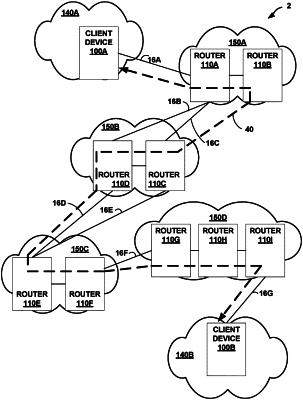| CPC H04L 45/122 (2013.01) [H04L 9/3242 (2013.01); H04L 45/126 (2013.01); H04L 45/22 (2013.01); H04L 45/24 (2013.01); H04L 45/745 (2013.01)] | 18 Claims |

|
1. A first router comprising:
a routing engine; and
a packet forwarding engine,
wherein the routing engine is configured to:
receive, from a first client device, a first packet including a request to establish a session between the first client device and a second client device;
identify a path maximum transmission unit (MTU) corresponding to a path between the first router and a second router, wherein the path represents a route from the first router to the second router through a set of routers including the first router and the second router;
identify a maximum packet overhead size corresponding to the session between the first client device and the second client device over the path between the first router and the second router, wherein the first client device is connected to the first router, and wherein the second client device is connected to the second router;
calculate, based on the path MTU and the maximum packet overhead size, a path maximum segment size (MSS), wherein the path MSS represents a maximum packet payload size corresponding to the path;
inject first information indicative of the path MSS into the first packet;
forward the first packet through the set of routers to the second client device in order to inform the second client device of the path MSS;
receive, from the second client device, a second packet representing an acknowledgement of the request to establish the session;
inject second information indicative of the path MSS into the second packet; and
forward the second packet to the first client device to inform the first client device of the path MSS.
|